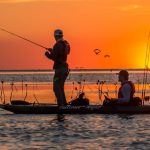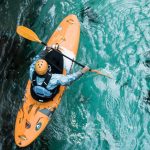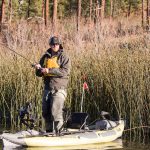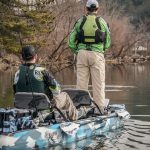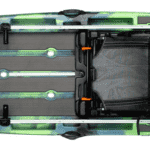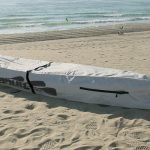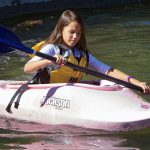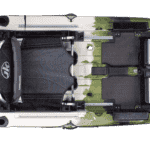Inflatable fishing kayaks are becoming more popular every year. But are they good? We've busted some myths about inflatables and picked some great models for you.
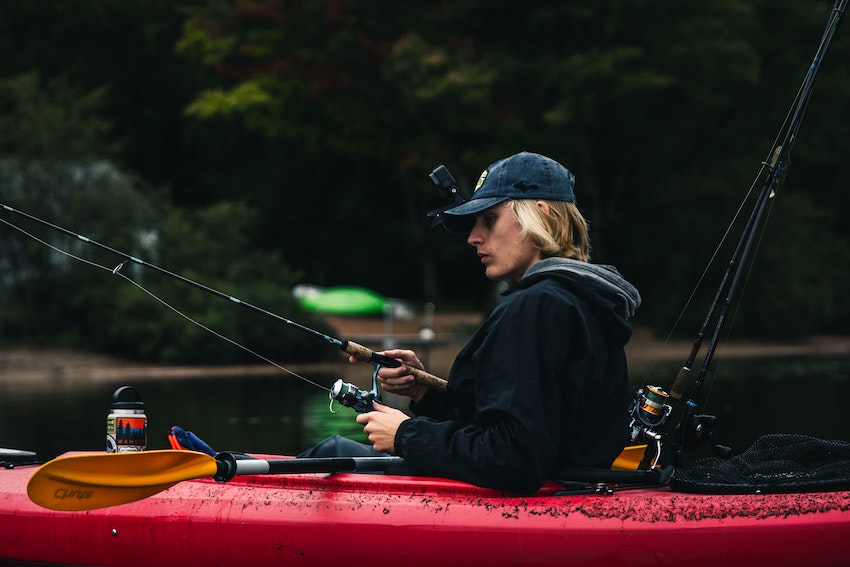
Your paddle is your closest companion on the water. Along with a PFD, it might be the most important accessory for any kayaker. Selecting the best kayak paddle for fishing depends on factors such as durability, weight, length, features, and of course price.
Not all paddles are equal. Finding the right paddle to suit you is important if you want to get the most out of your day of fishing.
As an affiliate of Amazon and other retailers, we may earn a small commission when you buy via our links, at no additional cost to you. Thank you!
Quick Answer: Best Kayak Fishing Paddles
- Best Overall: Bending Branches Angler Classic
- Best Budget Pick: Pelican Poseidon Angler
- Best Premium: Werner Shuna Hooked
- Carlisle Magic Angler
- Crooked Creek Tournament Angler
Comparison Table: Best Paddles for Kayak Fishing
| Model | Specs | Where to Buy |
 Werner Shuna Hooked | Shaft Material: Carbon and fiberglass blend Blade Material: Fiberglass Weight: 27.5 oz. (779 g) | Amazon |
 Pelican Poseidon Angler | Shaft Material: Aluminium Blade Material: Fiberglass reinforced polypropylene Weight: 38.6 oz. (1095 g) | Amazon |
 Crooked Creek Tournament Angler | Shaft Material: Fiberglass Blade Material: Poly-Fiber composite Weight: 42 oz. (1200 g) | Amazon |
 Carlisle Magic Angler | Shaft Material: Fiberglass Blade Material: Fiberglass polypropylene blend Weight: 42 oz. (1190 g) | Amazon |
 Bending Branches Angler Classic | Shaft Material: Fiberglass Blade Material: epX Engineered Polymer, Fiberglass reinforced Weight: 34 oz. (964 g) | Amazon |
Reviews: Best Paddles for Kayak Fishing
Werner Shuna Hooked
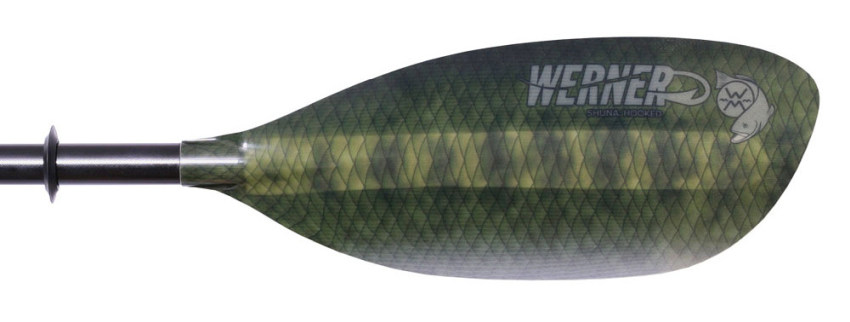
Shaft Material: Carbon and fiberglass blend.
Shaft Options: Straight shaft, two piece. 0° / 15° / 30° / 45° / 60° (Left or Right handed). 20 cm. Length adjustment with the ferrule.
Blade Material: Fiberglass
Blade Dimensions: 6.2 x 18 in. (16 x 46 cm)
Blade Size: Not stated.
Lengths: 220 – 240 / 240 – 260 / 260 – 280 cm
Weight: 27.5 oz. (779 g)
USRP: $315
That’s right, it’s Werner’s entry into the angling category, because, let’s be honest, it’s hard to have a performance category without Werner finding their way into it.
The Shuna didn’t start life as an angling paddle, but as a high performance touring paddle, and we seriously considered it instead of the Camano for the last category, but opted for the low angle tourer instead.
It’s a safe bet that if you want to go for long days on the water, buying a paddle which was originally designed for touring means you can’t go too far wrong. It’s also really light, so you’ll quickly forget that you’re swinging it around and you can get on with searching for a fishing spot.
With powerful, high angle blades made from fiberglass, you can be certain of the solid catch and release that people have come to associate with Werner’s paddles.
The shaft, meanwhile, is a carbon/fiberglass blend, keeping it really light but with just enough give to stop your wrists getting strain injuries on longer paddling days.
The Shuna Hooked comes with a ferrule which not only allows you to change your paddling feather in fifteen degree increments, but you also get twenty centimetres of length adjustment too.
What we like
- It’s an awesome touring paddle, perfect for long days out on the water
What we don’t like
- Expensive if you’re just after a fishing paddle
Pelican Poseidon Angler

Shaft Material: Aluminium
Shaft Options: Straight shaft. 0° or 65° feather (left or right handed).
Blade Material: Fiberglass reinforced polypropylene
Blade Dimensions: Not stated.
Blade Size: Not stated.
Lengths: 230 / 240 / 250 cm
Weight: 38.6 oz. (1095 g)
USRP: $49.99
Pelican are known in the kayaking world for making affordable gear. Their kayaks and paddles tend to be towards the more introductory end of the market, but that doesn’t mean they’re not totally appropriate for a lot of people’s needs.
The Poseidon Angler is a solid paddle, designed to be used by novices or in areas where you don’t need to paddle long distances to start fishing. The aluminium shaft and fiberglass reinforced polypropylene blades make this a really strong, solid design.
The blades are stiff enough to be responsive and to not flutter in the water, but flexible enough that you aren’t likely to shatter them if you bounce them off rocks, or get them caught under the boat as you launch and land.
WIth a two piece shaft and pop button design, you can easily change your angles between zero degrees, or sixty-five degrees either left, or right handed.
Along the length of the shaft is an incorporated tape measure, to see how impressive your catch is. There’s also a retrieval hook built into the blade, just in case you snag your line on something as you go.
What we like
- Cheap and easy to use
- Sturdy design with plenty of options
What we don’t like
- A beginner option, designed for short trips rather than long days out
Crooked Creek Tournament Angler

Shaft Material: Fiberglass
Shaft Options: Straight shaft. 0° or 60° (Left or Right handed)
Blade Material: Poly-Fiber composite
Blade Dimensions: Not stated.
Blade Size: Not stated.
Lengths: 213 / 244 / 274 cm
Weight: 42 oz. (1200 g)
USRP: $68.99
The Crooked Creek Tournament Angler is, to put it simply, quite a lot of paddle for the price you have to pay. It’s cheap, but it doesn’t feel like you’re using a bargain paddle.
With a fiberglass shaft and poly-fiber composite blades, you get a stiff and responsive paddle stroke, and it seems to be surprisingly powerful for the design. That said, although Crooked Creek don’t provide the exact blade dimensions, a few reviews do state that they feel a little small, perhaps then not a great choice for anyone who really needs a powerful stroke. They’re potentially not a long distance option, either, weighing in at a hefty forty-two ounces.
That’s the negatives out the way, but in reality, if you know what you’re getting into, you could do a lot worse than the Tournament Angler. Both blades have hook retrieval systems on them. There is also a measuring tape along the shaft, though this only lines up if you’ve got your paddle set without a feather.
The shaft system of a push-button ferrule allows you to quickly and easily change how you’ve got your paddle set up, whether you want zero, or sixty degrees of feather either right or left handed.
All in all, this paddle has its ups and downs, but for the price, it’s a really good option.
What we like
- Lots of paddle for the price
- Solid and dependable paddle
What we don’t like
- Small blades can limit power
- Heavy
Carlisle Magic Angler

Shaft Material: Fiberglass
Shaft Options: Straight shaft. 0° or 60° (Left or Right handed)
Blade Material: Fiberglass polypropylene blend
Blade Dimensions: 7.25 x 18 in. (18.5 x 45 cm)
Blade Size: Not stated.
Lengths: 230 / 240 / 250 / 260 cm
Weight: 42 oz. (1190 g)
USRP: $119.99
Another heavy duty option, the Carlisle Magic Angler is slightly more refined than the Crooked Creek Tournament Angler, with smooth, high angle blades which catch and release the water smoothly and effectively.
High angle blades are slightly at odds with fishing kayaks, which are notoriously wide, lending themselves to lower angle paddling. However, these Magic Anglers come in such a range of lengths that you won’t have to worry about overreaching, especially if you’re sitting well clear of the water.
The fiberglass shaft keeps a level of stiffness to your paddling, while stopping this paddle from ending up being even heavier than it already is. This shaft has a pop-button ferrule, which can be adjusted depending on whether you want your blades in line with one another, or offset by sixty degrees.
The shaft itself is ovalised, rather than perfectly round. This gives you a more comfortable hold on the paddle, and works to keep your hands in the right position; ideal if you’re just starting out.
Also on the shaft is a tape measure, while the blades have a hook retrieval system.
What we like
- Progressive paddle design at an affordable price
- High angle blades give good, direct power
What we don’t like
- Heavy
Bending Branches Angler Classic
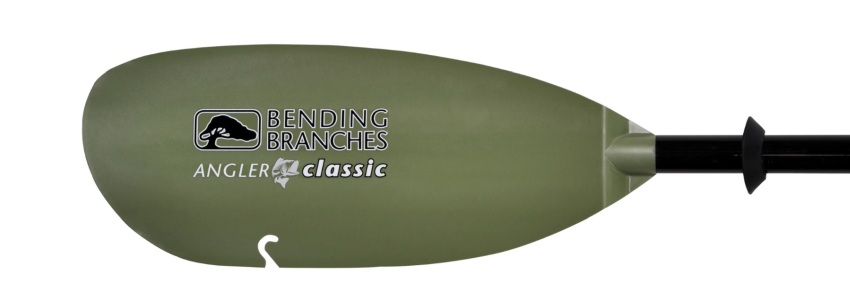
Shaft Material: Fiberglass
Shaft Options: Straight shaft. 0° or 60° (Left or Right handed)
Blade Material: epX Engineered Polymer, Fiberglass Reinforced
Blade Dimensions: 6.9 x 17.5 in. (18 x 44 cm)
Blade Size: 95 sq. in. (613 sq. cm)
Lengths: 220 / 230 / 240 / 250 / 260 / 260 / 270 / 280 cm
Weight: 34 oz. (964 g)
USRP: $139.95
Do kayak fishing paddles come much more popular than this? Bending Branches certainly think not. This paddle is a step up from their entry level designs. This is a solid paddle which would be perfect whether you’re just starting out, or want something to stick with for years to come. Actually, the Angler Classic is our top pick paddle for kayak fishing.
This is, by the standards of plastic bladed paddles, pretty lightweight. The fiberglass shaft helps this quite a lot, keeping the paddle stiff and responsive, but also sturdy and comfortable to use over longer distances.
The blades, meanwhile, are really strong. This strength comes from the polymer design, which is reinforced with fiberglass to save some weight and make sure they retain that catch and power through the stroke which Bending Branches paddles are renowned for.
You can get hold of the Angler Classic in the snap button design, which gives you a few choices for feather and a huge selection of lengths. Alternatively, you can buy their “plus” model, which comes with a fully adjustable ferrule, which allows you to change the length of the paddle as well as playing through an infinite selection of feather angles. Of course, this comes with a higher price.
If you’re taken by the Bending Branches paddles, but want something a little lighter, there’s always the Angler Pro, a similar paddle design but with fully fiberglass blades, very similar to the next paddle on this list.
What we like
- Paddles don’t become this popular without a good reason
- Strong, smooth design for long days out
What we don’t like
- Limited options if you don’t jump up to the “plus” model
Best Paddles for Kayak Fishing: Factors to Consider
Paddle Length: What size of paddle do you need for kayak fishing?
Size is perhaps the most important factor when picking a paddle. Too short and you won’t be able to comfortably reach the water and use proper technique. Too long and you will find the paddle feels heavy and difficult to use.
Fishing kayaks are usually much wider than other styles of kayaks. Modern sit-on-top kayaks also often have framed seats that are raised above the deck.
Combine these two factors and you need to have a much longer paddle to avoid hunching in order to reach the water.
The length of the paddle is determined by your height and the width of your kayak. The recommended sizes differ depending on the manufacturer.
Here’s what major paddle brands recommend:
Bending Branches Fishing Paddle Sizing Guide
Kayak Width | Paddler Height: Up to 6’ | Paddler Height:6’1” and taller |
| Under 28” | 230 cm | 240 cm |
| 28 – 31.75” | 240 cm | 250 cm |
| 32 – 35.75” | 250 cm | 260 cm |
| 36 – 39.75” | 260 cm | 270 cm |
| 40” and over | 270 cm | 280 cm |
Check Bending Branches’ complete sizing guide here.
Aqua-Bound Paddle Sizing Guide
Aqua-Bound does not have a separate sizing guide for fishing paddles. They also don’t make paddles longer than 250 cm, so if you’re tall and/or have a wide kayak, you might want to check other manufacturers.
Kayak Paddle Sizing Guide
| Kayak Width | Under 23″ | 23″ to 27.75″ | 28″ to 32″ | Over 32″ |
| Paddler Height:Under 5′ | 200 cm | 210 cm | 220 cm | 230 cm |
| 5′ to 5’6″ | 210 cm | 220 cm | 230 cm | 240 cm |
| 5’7″ to 6′ | 220 cm | 220 cm | 230 cm | 240 cm |
| Over 6′ | 220 cm | 230 cm | 240 cm | 250 cm |
Here’s a link to Aqua-Bound’s complete paddle sizing guide.
Werner Paddle Sizing Guide
Werner takes it a step further. They have separate sizing charts for high-angle and low-angle kayak fishing paddles:
Low Angle Fishing Paddles
| Kayak Style | Kayak Width | Paddlers up to 6′ tall | Paddlers 6′ tall and over |
| Sit-inside | 28″ and wider | 230 cm | 240 cm |
| Sit on Top | 28″ to 34″ | 230 cm | 240 cm |
| Sit on Top | 34″ and Wider | 240 cm | 250 cm |
| Sit on Top, Raised Seat | 30″ to 34″ | 250 cm | 260 cm |
| Sit on Top, Raised Seat | 34″ and Wider | 260 cm | 260 cm |
High Angle Fishing Paddles
| Kayak Style | Kayak Width | Paddlers up to 6′ tall | Paddlers 6′ tall and over |
| Sit-inside | 28″ and wider | 220 cm | 230 cm |
| Sit on Top | 28″ to 34″ | 220 cm | 230 cm |
| Sit on Top | 34″ and wider | 230 cm | 240 cm |
| Sit on Top, Raised Seat | 30″ to 34″ | 240 cm | 250 cm |
| Sit on Top, Raised Seat | 34″ and wider | 250 cm | 260 cm |
You can find Werner’s complete paddle sizing guide on NextAdventure.com
Adjustable Length Paddles
But what if you have two kayaks? Do you need a paddle for each one? Or what if your kayak has a framed seat with high and low positions (or, as is the case with FeelFree Lure, 10 height positions)?
If you’re undecided about length, there are some adjustable paddle models. They let you quickly change the length of the paddle to suit your needs on the water, rather than carrying a spare or dealing with a paddle the wrong length.
Blade Shape: High-angle vs. Low-angle Paddling
You’ve probably heard about two paddling styles, low-angle paddling and high-angle paddling.
Low-angle paddling is when your upper hand does not go higher than your shoulder. This is a more relaxed style of paddling that lets you spend many hours on the water. Paddles made for low-angle paddling have longer and narrower blades.
High-angle paddling is a more aggressive style that lets you go faster or push more weight. High-angle paddle blades are wider and shorter, made for powerful strokes that move a lot of water.
The choice between a high-angle and a low-angle paddle depends on your style of kayak and your preferred technique. Wider boats usually lend themselves to a low-angle blade. This style of paddle gives you longer cruising strokes which uses less energy.
High-angle blades suit narrower boats and more high-paced environments. These are better suited to short bursts of energy and therefore aren’t common among kayak anglers. Keeping your paddle away from your kayak reduces splashing and knocking, both of which can scare off fish.
Materials: What Are Fishing Paddles Made Of?
Kayak paddles are commonly made of three types of materials; plastic, fiberglass, and carbon. The shafts on some cheaper models can sometimes be made from aluminum. These materials are used in various ways by different manufacturers to create paddles that perform differently.
Blade Materials
Plastic
Plastic is the cheapest and most durable material used for paddle blades. Usually, this will be some form of nylon which is often reinforced with either fiberglass or carbon. This reinforcement stiffens the plastic and makes the paddle more responsive.
Fiberglass
Fiberglass sits somewhere in the middle of the range. Fiberglass blades are responsive and transfer energy well without unwanted flex. They can damage over time though and aren’t as durable as plastic blades.
Carbon
Carbon is the most expensive and lightest material for paddle blades. It is also by far the least durable option. Carbon blades are very stiff and suited to longer days of paddling where you have to cover bigger distances without fatigue.
Shaft Materials
Aluminum
Aluminum shafts are the cheapest and heaviest shafts available. These do the job but are cold and uncomfortable to use.
Fiberglass
Fiberglass shafts are most common. These offer enough flex to protect your wrists as you paddle while remaining responsive. These shafts combine well with all blade types.
Carbon
Carbon shafts are expensive and very stiff. Carbon shafts combine well with all types of blades, but the lack of flex in a full carbon paddle can put a lot of strain on your wrists. For this reason, a lot of carbon shafts are available as bent shafts, giving you a more ergonomic design.
One-piece or split paddles
Traditionally, kayak paddles came in one piece. These are still the most popular style of paddle and remain the strongest and most responsive paddles. However, they have their limits.
Split paddles can be divided into either two or four pieces, depending on their design. This not only makes them a lot more transportable, but you can also store them more effectively on the water. This keeps them well out of the way while you fish.
Split angling paddles are often adjustable. Some of these allow you to change the length as we looked at earlier. Most allow you to change the feather, so you can choose how much of an angle you want on your paddle.
You might be wondering why you would want to adjust your angle. Well, if it’s particularly windy, a higher angle makes stroke recovery easier. In low wind conditions, a smaller angle helps to protect your wrists.
Fishing-specific features
Ultimately, the best paddles for kayak fishing are going to be the paddles that are best for kayaking. The main function of your paddle is to get you around on the water. But there are a few extras that can be thrown in to give your paddle the edge.
Some paddles come with tape measures marked down the shaft, so you can easily check out the size of your catch. There are also paddles with hook retrieval systems built into the blade.

